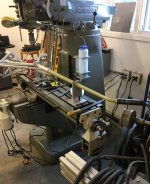rickbrennan
Plastic
- Joined
- Jan 19, 2018
- Location
- Boulder, Colorado, USA
I'm having trouble with machining for a tapered pin in HRC 45 round stock. The pin holds the main landing gear leg in the fuselage mount for an experimental aircraft. We step drilled using a progression of lettered drill bits before using a tapered high speed steel straight flute reamer on a Bridgeport mill at 60 rpm. We used flood coolant, cleared chips every 5 seconds or so by backing out and blowing the reamer off with compressed air. At first the reamer cut well. About .100 short of the minimum pin depth, the reamer stopped cutting.
I looked for a carbide tapered reamer, but all I seem to be able to find are HSS. Not sure if we work-hardened the taper, or what the problem is. Recommendations would be appreciated.
I looked for a carbide tapered reamer, but all I seem to be able to find are HSS. Not sure if we work-hardened the taper, or what the problem is. Recommendations would be appreciated.


